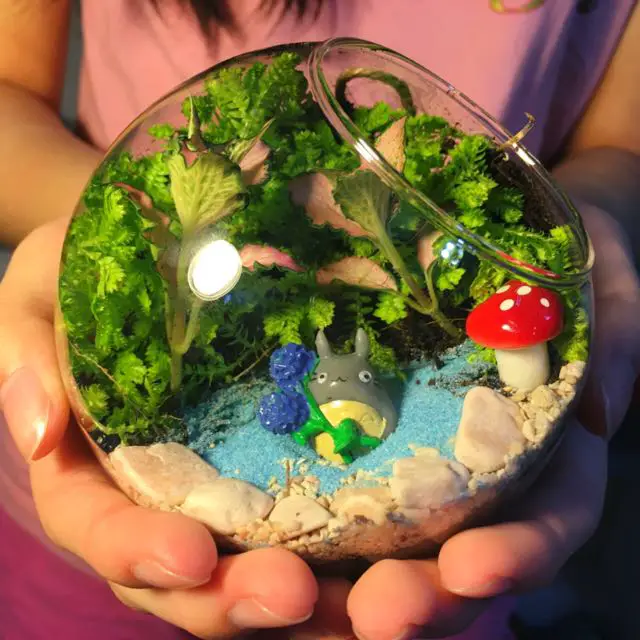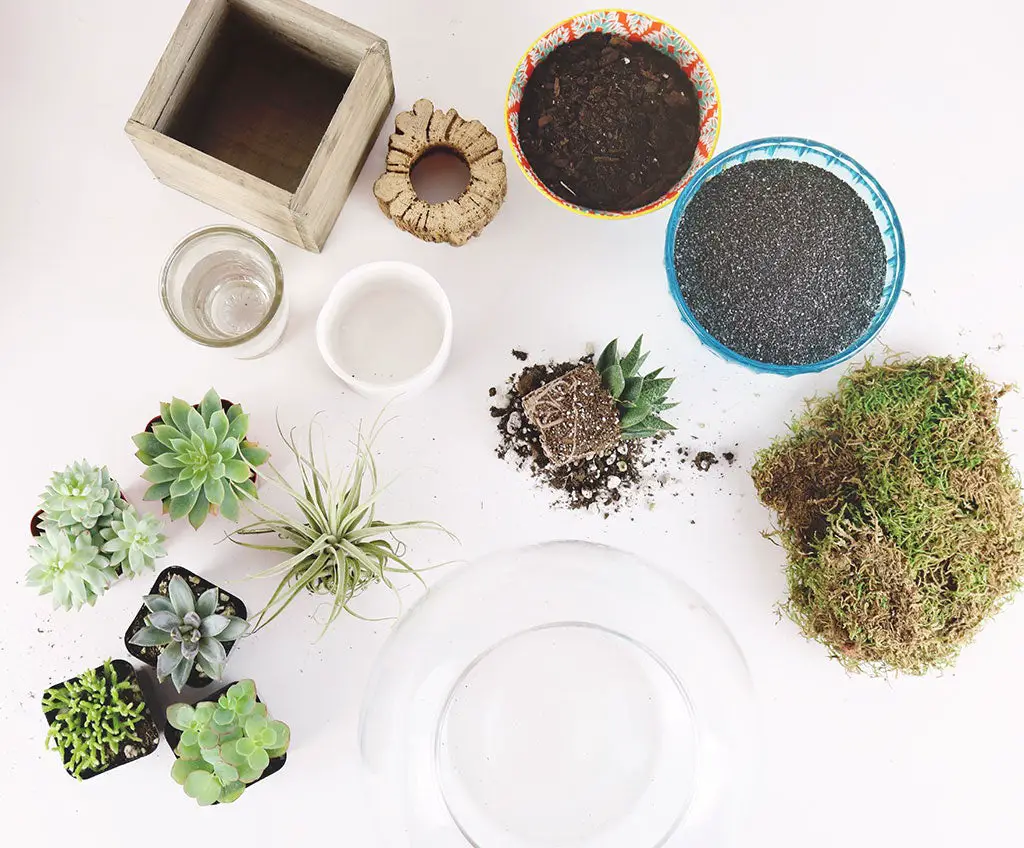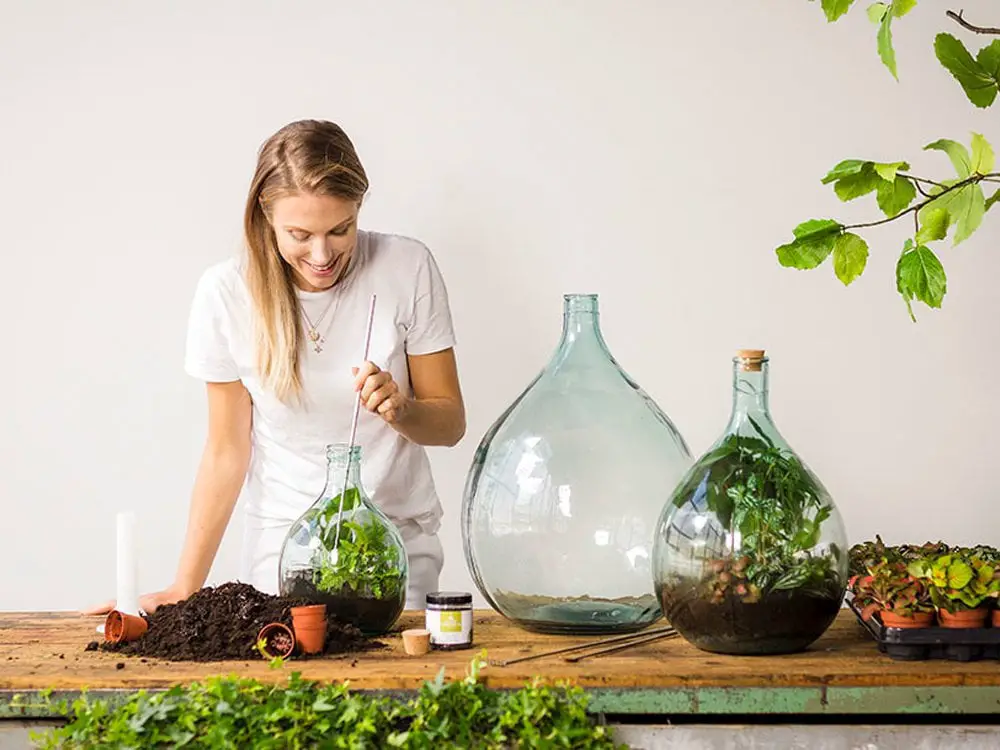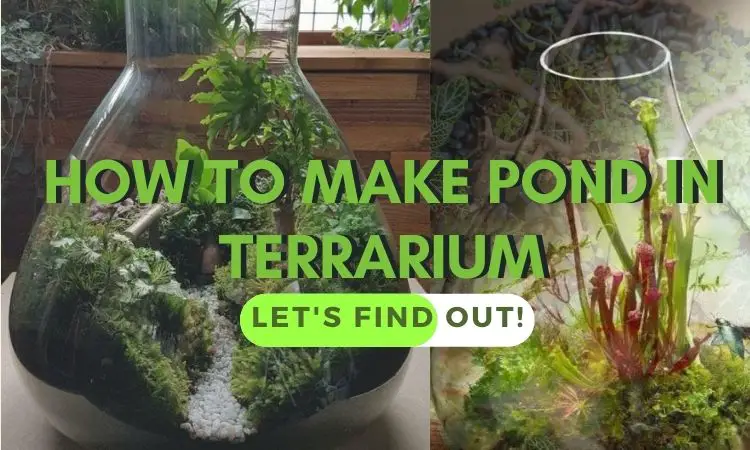Terrariums are one of the most complex ecosystems you can build. However, one of the most complicated parts of a terrarium is making a pond in it.
Since the terrarium is a closed setting, making and maintaining a pond is kind of challenging. So, we’re here to help you with how to make a pond in a terrarium?
To make a pond in a terrarium, you need to have a large enough tank. Divide the tank accordingly, and make drainage layers. Afterward, pour the water and add a pump to keep it running. Ensure lighting and maintenance and you’re good to go!
We understand the whole process is a bit tricky. There’s a lot of factors that need to be kept in mind. But don’t be tense! We’re here to guide you throughout the entire procedure.
So, let’s get into business!
Can You Make a Pond in a Terrarium?

Source: https://www.carousell.sg/p/
The short answer is, yes! You can make a pond in a terrarium. However, you have to understand how a terrarium works before making a pond.
A terrarium is generally considered a small greenhouse. It’s used to grow small plants in a dry environment. There are two types of terrariums, sealed and open. While sealed terrariums are used for plants only, open terrariums can also act as housing for animals.
Generally, open terrariums are used for animals like lizards. So, you can’t make a pond in such terrariums. A closed terrarium, however, is a complete system on its own. It requires its own cycles of water, lighting, and moisture.
So, once you have a fully running terrarium, you can build a pond there!
Terrarium Pond vs Vivarium Pond: What’s the Differences?
The terms terrarium and vivarium are often used interchangeably. However, there are a number of differences between them that we usually overlook.
The vivarium is the umbrella term that’s used to describe a number of other enclosures. Technically, aquariums, terrariums, mossariums, etc. are all different kinds of vivariums. But, there are a few differences between a Vivarium pond and a pond for a terrarium.
Generally, vivariums are larger and can be varied in style. They can have fishes, aquatic animals, terrestrial animals, etc. based on the type of the terrarium.
Thus, the ponds in a vivarium are made keeping those in mind. However, in a terrarium, the ponds are made smaller depending on the usage.
DIY Terrarium Pond: Step-by-step
Before you make a pond in your terrarium, you need to make sure it’s self-sustaining. So, how do you make a self-sustaining terrarium?
To make a self-sustaining terrarium, you need to make sure all parts of it are working. The terrarium must be sealed and used only for plants. It should be a self-sustaining ecosystem where the plants and all-natural aspects work properly.
Physiological functions such as photosynthesis and respiration should work seamlessly. Also, make sure there’s a door for you to fix things in case of a problem!
With that said, let’s discuss the steps for making our own terrarium pond. Let’s begin!
Preparation
Before we start building, we need to prepare. The tank needs to be prepared and made ready for work. For that, we need to prepare first. You have to choose the right container and prepare the container accordingly.
Choosing the Container
So, what kind of container do you need? Firstly, you cannot make a pond in something as small as a jar. So, keep those out of the equation.
Containers like fish tanks and aquariums are great as terrariums. However, you have to make sure the glass is thinner than normal aquariums. Furthermore, you need at least to make sure it’s at least 5’ in length. Otherwise, you won’t be able to fit everything.
Preparing the Container
Now that we’ve chosen our container, we need to prepare it. The container must be clean on the inside and outside. Also, any sort of residue or anything that can sit on it must be avoided.
So, start preparing the container a few days before you start your terrarium. Make sure all the corners are thoroughly clean. Afterward, let it dry completely. I personally use some cleaners that are very best at removing hard and rough stains. Here’s a list of these cleaners for your convenience.
| Buy | Image | Cleaner | Benefits |
|---|---|---|---|
| Shop Now! |  | Windex Original Blue Glass and Window Cleaner Bundle | Starts working on smudges, smears, dirt, and grime even before you wipe |
| Shop Now! |  | Sprayway 443331 Ammonia Free Glass Cleaner, 19 Oz. (4-Pack) | Never leaves a haze or streaks |
| Shop Now! |  | Hope's Perfect Glass Cleaner, 2 Piece | Amonia-free and safe for screens |
Keep it in a cool place and dry it completely. Once it’s completely clean and dry, it’s ready for work!
Gathering Necessary Items

Source: https://www.afloral.com/blogs/
Now that the container is ready, it’s time to start on the technical stuff. You need a few things to set up a vivarium. Keep these in hand and you’re good to go.
If you have a canister filter, make sure the filter is primed in this phase as well.
The list of materials you need for your terrarium pond kit is-
Preparing the Soil
The soil of the terrarium is key to its stability. You need to make sure the soil holds the water while providing for the plants. So, you need to mix the soil accordingly.
Now, terrarium soil can be of three types, tropical, bog, and standard. You have to plan your terrarium based on the soil and arrange accordingly. Depending on the type of plants you want to grow, you need to make your soil mix.
However, if you’re planning to make a soil mix that’s ideal for a pond, you need to make some changes. It’s important that your soil mix holds off the water as well as its structural integrity. So, you have to choose the materials accordingly.
Our recommended sizes include 1 part Coco Fiber, 2 parts sphagnum moss, 1 part sand, 1 part potting mix, and 1 part active charcoal. Based on the size of your tank, mix them accordingly.
Once the soil is ready, move on to the next steps!
Preparing the Plants
What makes the terrarium worth the effort are the plants! So, you need to choose plants carefully and nurture them!
Now let’s see what plants you can put in a terrarium?
Your choice of plants depends on the type of soil you have. If you have tropical soil, then put in the tropical plants. In case your soil is sandy, desert plants are the way to go. However, make sure the root systems of your plant work with the size of your terrarium.
Here are some tropical and desert plant recommendations to help you with the process. Take a look-
Make sure you’re choosing the best plants for the terrarium based on your needs. Also, ensure the roots of your plants are in good condition. Some plants might need to be rooted to fit your system. So, check that as well.
Creating the Terrarium
Once we have everything prepared, we need to start making our closed terrarium with a pond. Follow the steps carefully and you’re good to go!
Step 1: Add Drainage Layers
The first, and most important step is to make a drainage layer. You have to start with the drainage layer to make sure everything else is working.
The drainage layer catches any water that flows through the substrate. Thus, preventing any saturation of water and waterlogging. So, having more layers is always a good idea when it comes to drainage.
If you’re wondering how to make the drainage layers for the terrarium, it’s simple-
Place a layer of something solid as the foundation. It could be something like pebbles or rocks. Afterward, add a separating layer of activated charcoal. The layer is ready and good to go!
The steps are described below-
Add Small Stones or Pebbles in the Bottom
Start your drainage layer by placing small stones or pebbles. Make sure the stones are of uniform size and the layer is even. The layer of stones should be at least 1-inch tall. The stones shouldn’t leave too much space lying around.
Add Activated Charcoal
Since we’re building a pond in our terrarium, there will be a lot of emphasis on drainage. So we recommend adding activated charcoal along with the rocks. Take activated charcoal and place it across the layer of rocks.
Emphasize the part where the land meets the water. Make sure that you have put enough charcoal to keep the layers separate.
Once you’ve placed the charcoal, move on to the next steps.
Step 2: Add Moss and Soil Mix
Now, you need to keep the drainage layer and the substrate separate. So, take a layer of sphagnum moss and spread it across your tank.
Make sure the entirety of the rocks and charcoal has been covered by the moss. This is the first step to your DIY moss terrarium.
If you find the moss too hard to work with, you can opt for something like carbon fiber mesh as well. Once the moss is set, put your soil mix and make it even. The base of your terrarium is ready to go!
Step 3: Structuring the Pond
Now, it’s time to prepare the hardest part of the terrarium, the pond. Dealing with the pond can be hard, so be careful. It’s better to have the pond in the center for easy access.
To begin with, remove soil from the center and make room for the pond. Make sure you aren’t moving the moss or the charcoal layer. Once you’ve prepared the soil, your pond is ready to be filled.
However, make sure the pond is connected to one end where it will meet the pump.
Step 4: Add Aquatic Plants to the Container
Now it’s time to put the plants in the container. As discussed before, your terrarium should have enough water to function properly. So, make sure you’re careful with the plants.
Choose plants that will work with your soil system. Here, some plants will not suit your root system. So, make sure the roots are compatible with your selected plants.
Also, if you want to add any decorations, this is the time. If you’re planning to add driftwood, make sure you know how long it takes to sink.
Finishing up

Source: https://www.homeandgardenextras.com/
We’re almost done with setting up our terrarium. A bit more effort and we’re good to go! The last steps are-
Step 1: Set Up a Pump
Setting up a tank is the first step to having a running terrarium. To begin with, make sure you have a good water pump and adequate tubing. The steps for setting up a pumping waterfall are-
- Use corrugated plastic to set up the back of the waterfall. Fold and cut plastic sheets to your required size of the waterfall. Make sure the pipes go behind the sheets.
- Cut some notches at the bottom of the plastic to help the water pass. Connect the entire thing with hot glue.
- I actually used glue guns at this point as I didn’t want to take any risk of a loose connection. So the two glue gun I had the best experience with are Gorilla Dual Temp Mini Hot Glue Gun, it comes with 30 hot glue sticks. And Cobiz hot glue gun, it comes with 10 premium hot glue sticks.
- Now, make a plastic or foam enclosure for your pump. You can place it either inside the pipes or hide it inside the decorations.
- Once the glue is set, turn the pump on to see if it’s working. If the pump is working, you’re good to go to the next steps!
Step 2: Add Water
Now that the pump is set, it’s time to finish our terrarium with running water. Fill up the terrarium with water and turn on the pump. If it’s running, it’s set.
Step 3: Provide a Light Source
Now, the plants in your terrarium need light to survive. If you can keep it near the sun, you won’t need any separate sunlight. However, if you keep it without the sun, you need to have lights on top of your terrarium.
A good aquarium light will work perfectly for your terrarium. Make sure it has a day-night cycle and you’re set. If you’re looking for recommendations, the Kessil h80 is worth a shout! The light is perfectly blended and covers an area of 14-24″. Some more high-range LED lights I’ve used and can suggest are sketched in the following table.
| Price | Image | Product | Advantage |
|---|---|---|---|
| Order Now! |  | Kessil Two A360X Tuna Blue LED Lights | Comes with Controller & Two Goosenecks Package |
| Order Now! |  | REPTI ZOO Terrarium Light | Comes with memory function when power off |
Can You Put Fish in a Terrarium Pond?
The short answer is no! You cannot place fish in a terrarium. A terrarium is a closed system focused on plants. Furthermore, the material of the terrarium is generally thinner than that of a tank. So, it’s not ideal for fish to grow.
Is Terrarium Good for Fish?
If you have an existing terrarium, you can convert it into an aquarium. However, the current terrarium is not an ideal ground for your fish. The material of the substrate, the drainage, etc. is not adequate for your fish.
So, in case you’re planning to get a terrarium fish pond, we recommend starting from scratch.
Adding Other Animals to Terrarium Pond- Yes or No
It can be a great place for animals if you have a dry terrarium. Animals like turtles, lizards love the environment of a terrarium. However, if you have a terrarium filled with water, it’s not suitable for animals.
Similar to fish, the environment of a terrarium doesn’t support other aquatic animals either. Keep that in mind when planning your terrarium.
Can You Add a Waterfall in Terrarium Pond?
Yes! You can add a waterfall to a terrarium pond. You have to make sure you have a working pump and enclosures to hold the pump in place.
If you’re looking for something simple, you can use a kit similar to the naturalistic terrarium waterfall kit. Don’t worry. We’ve made a list of kits available in the market just for you-
| Price | Image | Title |
|---|---|---|
| Buy Today! |  | TetraFauna Decorative ReptoFilter |
| Buy Today1 |  | Zilla Waterfall Small |
Wondering how to use a kit, follow these steps-
- Take a plastic container and cut holes into it. Make sure the hole is big enough to fit the waterfall hose.
- Afterward, place the motor in the bowl and place it in the bottom.
- Now that it’s set, select the waterfall intensity on the remorse and connect the tubes to the motor. Close the lid and place it in your empty terrarium.
- Rinse the hydro balls in running water and place them in the bottom of the tank. Fill it up to the edge of the container.
- Place a thin layer of mesh and moss over the balls to conceal them. Build your pond plant terrarium and you’re good to go.
- Turn it on once you’ve added water.
These are the steps to set up a waterfall kit in your terrarium waterfall pond.
Terrarium Pond Maintenance Guide:
Now that we have a terrarium of our own, we need to know how to take care of it. Maintaining a terrarium pond can be a bit challenging. However, knowing the basic maintenance for the terrarium can help you greatly.
We now know how to put a pond in a terrarium. Let’s discuss how to take care of our terrarium-
Draining Out Water
You need to first make sure you have no water in your terrarium. Once the water is gone, you can start fixing its problems. The steps to draining out water are-
Step 1: Disconnect All Power Sources
The first step is to make sure it’s not connected to electricity. Disconnect the power source from the central line and remove all the wiring. Once the connections are removed, start the next steps.
Step 2: Remove Objects
Now, remove everything in your terrarium. Start from the plants to any additional decorations. If you have any animals in your terrarium, remove them as well.
Step 3: Draining
It’s time to start the draining of our terrarium. The steps of draining are-
Siphoning the water with a hose
You need to get rid of any excess water. The easiest way to do it is with a hose. Connect the terrarium to a hosepipe and siphon out as much water as you can. For this reason, it’s important to make it empty first.
Using a Gravel Cleaner
Now water and moisture can be stuck in your gravel as well. For that, take a gravel cleaner such as hygger Aquarium Gravel Cleaner and remove whatever moisture there is in the gravel. This cleaner is also ideal for removing dirt and dust from the gravel.
Dying and Overgrown Plants
If you have plants dying in your terrarium, it could be due to a number of reasons. So, you might ask, why are my plants dying in my terrarium?
Common reasons for dying plants include overwatering, choosing the wrong container, mixing the wrong plants, inadequate lighting, etc. You have to find the reason and deal with it.
Also, once you see dying plants, you might wonder, should you remove dead leaves from the terrarium?
Yes! Remove every sort of dead plant and animal from the terrarium. The plants might have contagious diseases. Unless removed, the disease will spread from one plant to another, across the tank.
You can also use some fertilizers for your plants’ better health. Some fertilizers that are full of great nutrients are-
| Price | Image | Fertilizer | Usage |
|---|---|---|---|
| Order Now! |  | Miracle-Gro Indoor Plant Food (Liquid) | All Indoor Houseplants Including Edibles |
| Order Now! |  | Liqui-Dirt Nano Powder All-Purpose Organic Complete Plant Food | Balanced Blend of Vitamins Minerals Micro-Fungi and Bio-Organisms for Indoor or Outdoor Use |
However, make sure the fertilizer is compatible with other terrarium animals and does not create any inconvenience for them.
FAQs
How do you make a water feature for a terrarium?
Depends on the type of feature. You can build decorations, waterfalls, etc. on your terrarium with ease. You can use materials like corrugated plastic to make your necessary features.
What’s the difference between a vivarium and a terrarium?
A vivarium is an umbrella term for a number of housings. These include aquariums, terrariums, refugium, etc. While a terrarium is a generally arid housing for plants and certain animals.
Should terrariums be open or closed?
Depends on the type of terrarium you’re using. If you have a dry terrarium for animals it has to be open. For terrariums with water, it has to be closed.
Final Word
Making a pond in a terrarium is a bit challenging. However, with the right resources and effort, it’s as easy as it gets. In this article, we’ve discussed how to make pond in terrarium in simple steps. We hope you find this useful!
Have a nice day!










